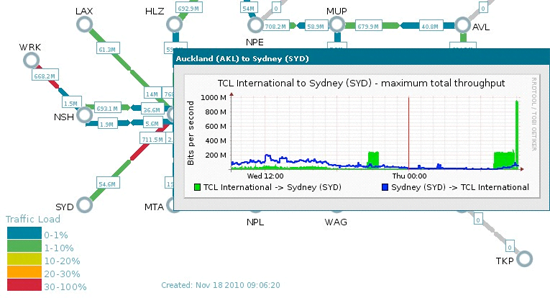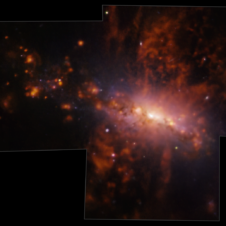Auckland University of Technology’s Institute for Radio Astronomy and Space Research and the International Centre for Radio Astronomy Research at Curtin University in Perth made a significant contribution to Australia – New Zealand SKA (Square Kilometre Array) development this week with a successful, high-speed data transfer trial.

Fragment of KAREN weathermap showing close to 1 Gbps data transfer rate from Warkworth NZ radio telescope to Australia. Credit: Sergei Gulyaev.
Data from AUT’s 12-metre radio telescope at Warkworth recorded during joint Trans-Tasman radio astronomical observations of radio galaxy Centaurus A, was successfully transferred to Curtin University at 1Gb/s. It took less than one hour to transfer 0.5 TeraByte of radio astronomical data from AUT to Curtin.
This was made possible by the recent upgrade of KAREN’s (Kiwi Advanced Research and Education Network) international connectivity between New Zealand and Australia from 155 Mb/s to 1 Gb/s. KAREN’s new international network went live on 15 November and provides the only research link between New Zealand and Australia. The new, upgraded service provides 1 Gb/s capacity to both Sydney and Los Angeles, greatly enhancing the opportunity for KAREN members to communicate and collaborate with the global research and education community.
Professor Sergei Gulyaev from AUT University says, “I congratulate REANNZ and the New Zealand Karen community for securing such a significant upgrade of international connectivity. For us, New Zealand radio astronomers, it opens up the opportunity for real-time operations and allows us to move from the technique of VLBI (very long baseline interferometry) to its real-time version, e-VLBI, the basic technique for future SKA.”
ICRAR’s Professor Steven Tingay says: “This is a very important milestone towards Australian—New Zealand SKA development. Electronic data transfer for the large data volumes generated in radio astronomy is an important technique that enables the maximum science to be extracted from our observations. This milestone will allow a wide range of science to be jointly undertaken by Australian and New Zealand radio astronomers”.

